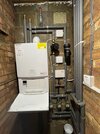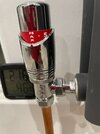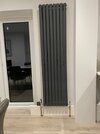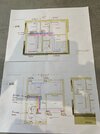Worth me saying how I got to this situation.
Updated old vented system to sealed system. Retained Valiant ecotech plus 424 boiler (24KW) and magnaclean filter. New Grundfos UPS3, Honeywell bypass, motorized valves for downstairs CH, upstairs CH and HW, Honeywell home wireless wall thermostats (one up one down), extended 22mm flow and return with localised 15mm feeding 5 vertical rads downstairs and 4 horisontal Stelrads plus towel rail upstairs. All have Drayton TRV4s. Pressure vessel in airing cupboard.
My loading is approximately 12.5 KW. Upstairs well insulated so that circuit hardly comes on leaving downstairs as the main loading. Flow temp set at 62C and pump on CP1. Bypass set 4.5.
Everything is good when starting from cold (TRVs all open). Velocity noise experienced from downstairs vertical rads (through TRVs). When boiler reaches working temperature at around 60C it maintains it for 20 minutes or so then gradually climbs before going into anti cycle mode ( set at 4 minutes). Pump then stops and starts again, boiler fires up for a few minutes until temp reaches 66C and starts anti cycle again. I have tried balancing the system via the locksheilds and the TRVs ( Draytons balancing key). The latter was worse. If all TRVs are on max the boiler holds the running temperature for much longer. Anti cycle mode is far less frequent. Whatever I try, the flow and return temperatures have no more than 10C difference at best.
Is it feasible that with "extended" 22mm flow and returns plus the new UPS3 the velocity is too high ?.
PS all pipework apart from direct connections to the boiler are plastic. (stabbings to rads are copper).
boiler setup, rad and valve pictures attached.






